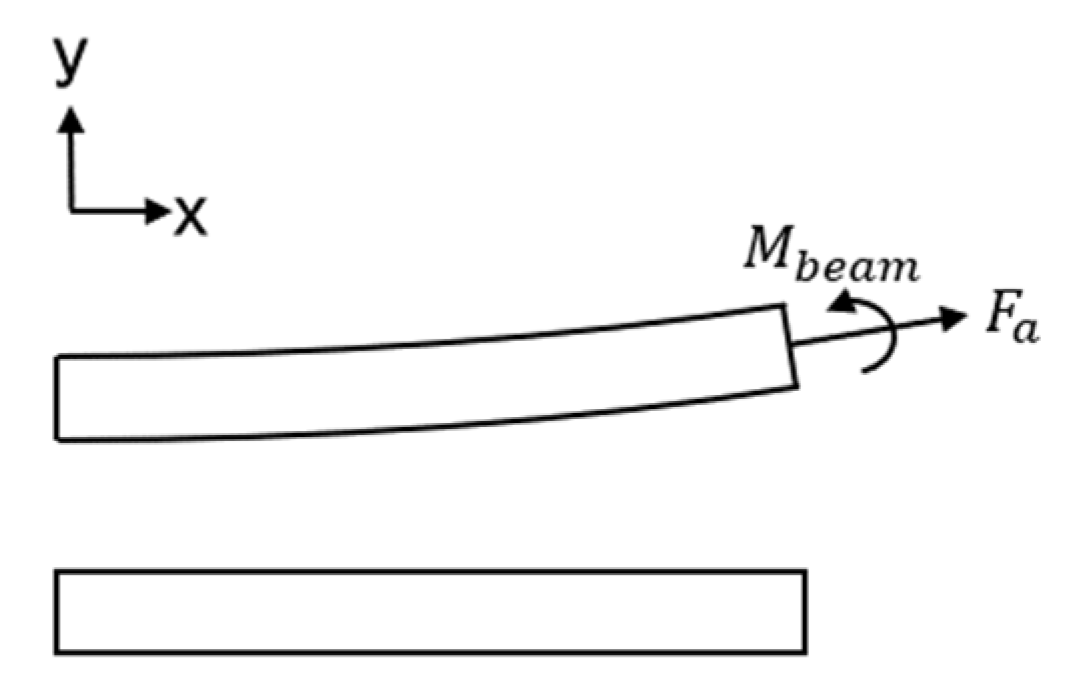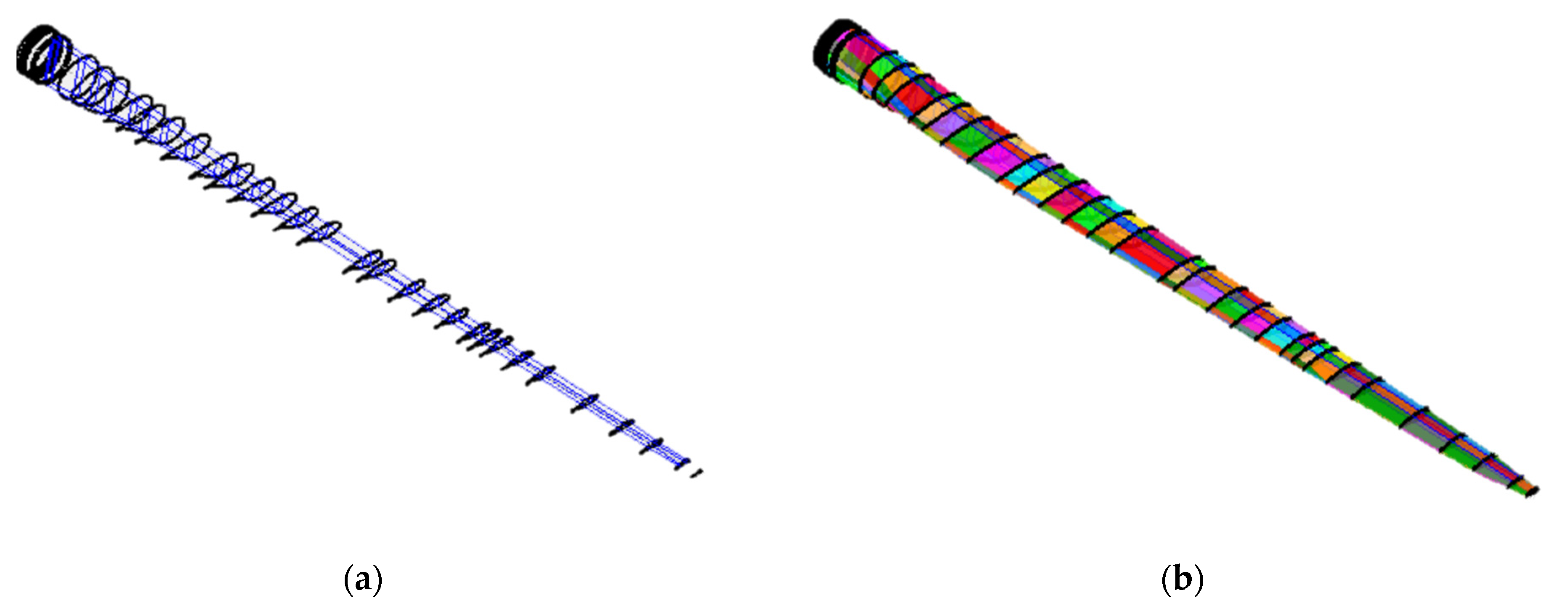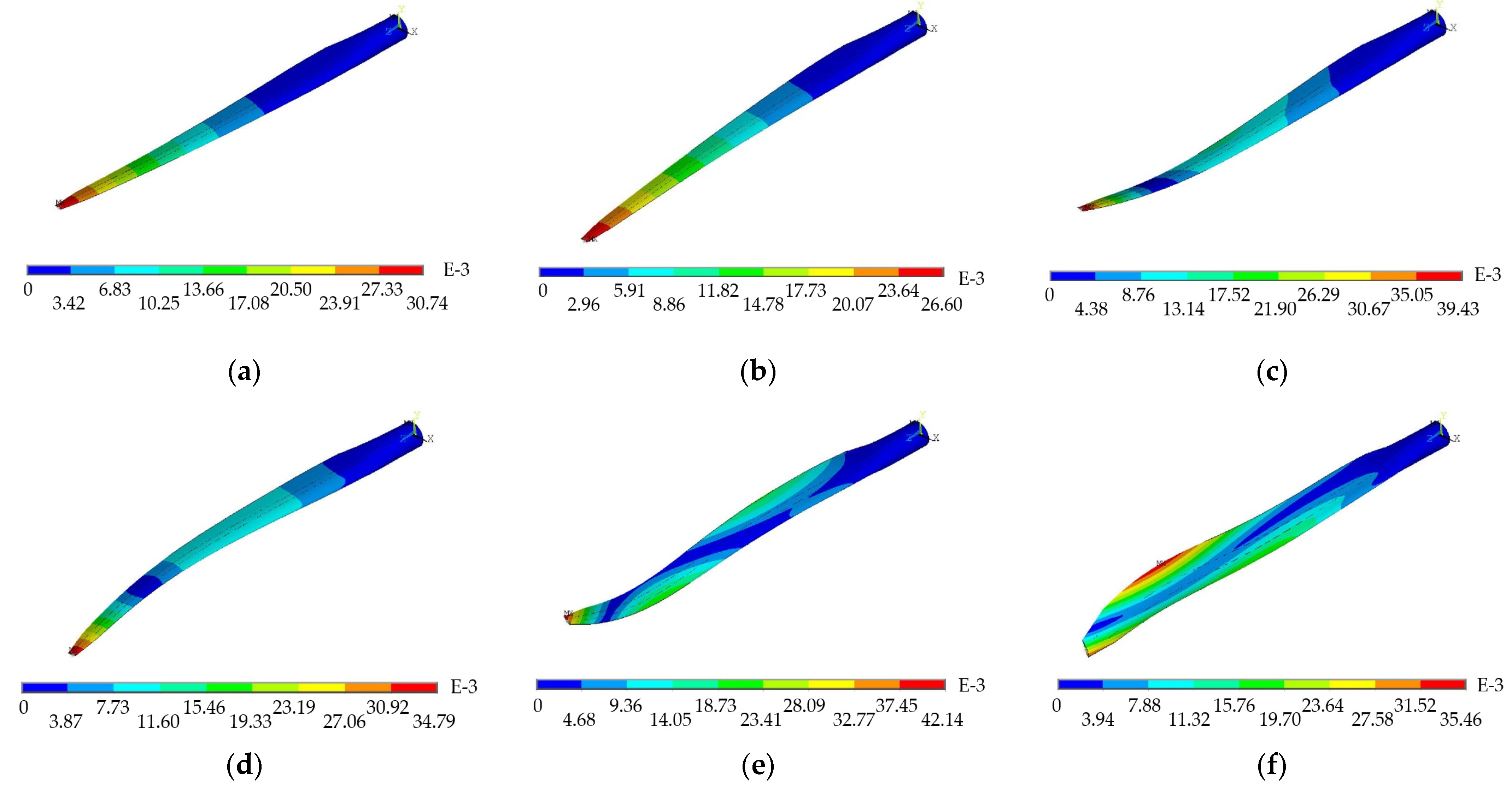Study on the Rotation Effect on the Modal Performance of Wind Turbine Blades
Abstract
:1. Introduction
2. Rotational Effect
2.1. Dynamic Stiffening Effect
2.2. Spin Softening Effect
3. Modal Analysis of Blades
3.1. Blade Model
3.2. Modal Analysis
- The first mode profile is flapwise; the second mode shape is edgewise; the third mode shape is flapwise; the fourth mode shape is a combination of edgewise and flapwise; and the fifth and sixth mode shapes are a combination of flapwise, edgewise and torsion.
- The torsional phenomena of blades only occur at high order, indicating that the torsional vibration frequency is higher than the vibration frequency of flapwise and edgewise bending. Since the vibration energy of the blade is concentrated in the first two orders, the bending vibration in the flapwise and the edgewise is the main vibration of the blade during the blade vibration process. Compared with the bending vibration, the contribution of the torsional vibration can be neglected.
- According to the structural mechanics and elasticity, there are fixed points, which are called vibration nodes, while blades rotate. When the frequency of the external force is close to the natural frequency of the blade, blade resonance is induced, causing severer structure vibration and finally breaking the blade at the vibration nodes. Most of the vibration nodes in the figure appear at the blade root and one-third of the distance from the blade tip, which is similar to the fatigue fracture point of most blades (blade root, blade tip and one-third of the distance from the blade tip). It is verified that the blade root and one-third of the distance from the blade tip are dangerous sections that are prone to fatigue damage.
4. Rotation Effect on Mode
- 4.
- The dynamic stiffening effect increases the natural frequency of the blade, which is more obvious in the low-order modal analysis. The rotating softening effect reduces the natural frequency of the blade, which is also more significant at low order.
- 5.
- The degree of frequency increase due to dynamic stiffening is related to the blade vibration mode, and its influence on the flapwise vibration is greater than its influence on the edgewise vibration. The degree of frequency reduction caused by spin softening is also related to the blade vibration mode, and its influence on the edgewise vibration is greater than that on the flapwise vibration.
- 6.
- Effects of dynamic stiffening and spin softening increase with the increase in angular velocity. As the angular velocity increases, the coupling effect of blade deformation and blade rotation becomes more obvious, and the centrifugal force has a greater impact on the blade deformation. Therefore, there is a positive correlation between the impact of the two effects on the natural frequency and the angular velocity.
- 7.
- The effect of dynamic stiffening is more significant than that of spin softening, and the results obtained by considering both effects are not only the superposition of considering any one of the effects.
5. Conclusions
Author Contributions
Funding
Data Availability Statement
Conflicts of Interest
References
- Boudounit, H.; Tarfaoui, M.; Saifaoui, D.; Nachtane, M. Structural analysis of offshore wind turbine blades using finite element method. Wind Eng. 2020, 44, 168–180. [Google Scholar] [CrossRef]
- Pellegrino, A.; Meskell, C. Vortex shedding from a wind turbine blade section at high angles of attack. J. Wind Eng. Ind. Aerodyn. 2013, 121, 131–137. [Google Scholar] [CrossRef] [Green Version]
- Pourazarm, P.; Caracoglia, L.; Lackner, M.; Modarres-Sadeghi, Y. Stochastic analysis of flow-induced dynamic instabilities of wind turbine blades. J. Wind Eng. Ind. Aerodyn. 2015, 137, 37–45. [Google Scholar] [CrossRef]
- Khan, M.; Iqbal, M. Dynamic modeling and simulation of a small wind–fuel cell hybrid energy system. Renew. Energy 2005, 30, 421–439. [Google Scholar] [CrossRef]
- Tapia, A.; Tapia, G.; Ostolaza, J.; Saenz, J. Modeling and control of a wind turbine driven doubly fed induction generator. IEEE Trans. Energy Convers. 2003, 18, 194–204. [Google Scholar] [CrossRef] [Green Version]
- Zheng, Y.; Cao, Y.; Zhang, C.; He, Z. Structural Optimization Design of Large Wind Turbine Blade considering Aeroelastic Effect. Math. Probl. Eng. 2017, 2017, 1–7. [Google Scholar] [CrossRef] [Green Version]
- Lee, J.-W.; Lee, J.-S.; Han, J.-H.; Shin, H.-K. Aeroelastic analysis of wind turbine blades based on modified strip theory. J. Wind Eng. Ind. Aerodyn. 2012, 110, 62–69. [Google Scholar] [CrossRef]
- Ismaiel, A.; Yoshida, S. Aeroelastic Analysis of a Coplanar Twin-Rotor Wind Turbine. Energies 2019, 12, 1881. [Google Scholar] [CrossRef] [Green Version]
- Kevin, M.; Ricardo, S.; Nickolas, V. System design of a wind turbine using a multi-level optimization approach. Renew. Energy 2012, 43, 101–110. [Google Scholar]
- Timmer, W.A.; Van Rooij, R.P.J.O.M. Summary of the Delft University Wind Turbine Dedicated Airfoils. J. Sol. Energy Eng. 2003, 125, 488–496. [Google Scholar] [CrossRef]
- Murtagh, P.; Basu, B.; Broderick, B. Along-wind response of a wind turbine tower with blade coupling subjected to rotationally sampled wind loading. Eng. Struct. 2005, 27, 1209–1219. [Google Scholar] [CrossRef]
- Lee, D.; Hodges, D.H.; Patil, M.J. Multi-flexible-body Dynamic Analysis of Horizontal Axis Wind Turbines. Wind Energy 2002, 5, 281–300. [Google Scholar] [CrossRef]
- Lesaffre, N.; Sinou, J.-J.; Thouverez, F. Stability analysis of rotating beams rubbing on an elastic circular structure. J. Sound Vib. 2007, 299, 1005–1032. [Google Scholar] [CrossRef] [Green Version]
- Zhu, T.-L. The vibrations of pre-twisted rotating Timoshenko beams by the Rayleigh–Ritz method. Comput. Mech. 2011, 47, 395–408. [Google Scholar] [CrossRef]
- Younesian, D.; Esmailzadeh, E. Non-linear vibration of variable speed rotating viscoelastic beams. Nonlinear Dyn. 2010, 60, 193–205. [Google Scholar] [CrossRef]
- Younesian, D.; Esmailzadeh, E. Vibration suppression of rotating beams using time-varying internal tensile force. J. Sound Vib. 2011, 330, 308–320. [Google Scholar] [CrossRef]
- Piovan, M.; Machado, S. Thermoelastic dynamic stability of thin-walled beams with graded material properties. Thin-Walled Struct. 2011, 49, 437–447. [Google Scholar] [CrossRef]
- Arvin, H.; Nejad, F.B. Non-linear modal analysis of a rotating beam. Int. J. Non-Linear Mech. 2011, 46, 877–897. [Google Scholar] [CrossRef]
- Kane, T.R.; Ryan, R.R.; Banerjeer, A.K.; Banerjee, A.K. Dynamics of a cantilever beam attached to a moving base. J. Guid. Control. Dyn. 1987, 10, 139–151. [Google Scholar] [CrossRef]
- Bakr, E.; Shabana, A. Geometrically nonlinear analysis of multibody systems. Comput. Struct. 1986, 23, 739–751. [Google Scholar] [CrossRef]
- Baumgart, A. A mathematical model for wind turbine blades. J. Sound Vib. 2002, 251, 1–12. [Google Scholar] [CrossRef]
- Naguleswaran, S. Lateral Vibration of a Centrifugally Tensioned Uniform Euler-Bernoulli Beam. J. Sound Vib. 1994, 176, 613–624. [Google Scholar] [CrossRef]
- Cárdenas, D.; Escárpita, A.A.; Elizalde, H.; Aguirre, J.J.; Ahuett, H.; Marzocca, P.; Probst, O. Numerical validation of a finite element thin-walled beam model of a composite wind turbine blade. Wind Energy 2011, 15, 203–223. [Google Scholar] [CrossRef]
- Nabi, S.M.; Ganesan, N. Comparison of beam and plate theories for free vibrations of metal matrix composite pre-twisted blades. J. Sound Vib. 1996, 189, 149–160. [Google Scholar] [CrossRef]
- Chen, H.; Yu, W.; Capellaro, M. A critical assessment of computer tools for calculating composite wind turbine blade properties. Wind Energy 2010, 13, 497–516. [Google Scholar] [CrossRef]
- Hodges, D.H.; Yu, W. A rigorous, engineer-friendly approach for modelling realistic, composite rotor blades. Wind Energy 2007, 10, 179–193. [Google Scholar] [CrossRef]
- Rao, J.S.; Sreenivas, R. Dynamics of a three level rotor system using solid elements. In Proceedings of the International Joint Power Generation Conference, Atlanta, GA, USA, 16–19 June 2003. [Google Scholar]
- Rao, J.S. Rotor dynamics of aircraft gas turbine engines. In Proceedings of the International Conference on Aerospace Science and Technology, Bangalore, India, 26–28 June 2008. [Google Scholar]
- Yao, X.S. Vibration Analysis of Transmission Shafts Using Solid Models. Appl. Mech. Mater. 2013, 397–400, 418–421. [Google Scholar] [CrossRef]
- Wallrapp, O.; Schwertassek, R. Representation of geometric stiffening in multibody system simulation. Int. J. Numer. Methods Eng. 1991, 32, 1833–1850. [Google Scholar] [CrossRef]
- Yoo, H.; Ryan, R.; Scott, R. Dynamics of flexible beams undergoing overall motions. J. Sound Vib. 1995, 181, 261–278. [Google Scholar] [CrossRef]
- Yao, X.S.; Chen, J.; Zheng, C.L. Dynamics of flexible beams based on spin softening. Chin. J. Appl. Mech. 2014, 31, 582–587. (In Chinese) [Google Scholar]
- Jian, K.L.; Yin, X.G. Computation of natural frequencies of a rotating beam. J. Chongqing Univ. Nat. Sci. Ed. 2001, 24, 35–39. (In Chinese) [Google Scholar]
- Vorpahl, F.; Popko, W. Description of the Load Cases and Output Sensors to be Simulated in the OC4 Project under IEA Wind Annex 30; Fraunhofer Institute for Wind Energy and Energy System Technology IWES: Bremerhaven, Germany, 2016. [Google Scholar]
- Jeha, R.; Kim, S.S.; Kim, S.S. A general approach to stress stiffening effects on flexible multibody dynamic systems. Mech. Based Des. Struct. Mach. 1994, 22, 157–180. [Google Scholar]
- Trindade, M.A.; Sampaio, R. Dynamics of Beams Undergoing Large Rotations Accounting for Arbitrary Axial Deformation. J. Guid. Control Dyn. 2002, 25, 634–643. [Google Scholar] [CrossRef] [Green Version]
- Liao, R.D.; Zuo, Z.X.; Chen, H.; Zou, W.S.; Rong, K.L. The Modal Characteristics Study of Turbine Blades with Considering the Influence of Spin Softening. Trans. CSICE (Chin. Soc. Intern. Combust. Engines) 2000, 18, 77–79. (In Chinese) [Google Scholar]
- Clough, R.W.; Penzien, J. Dynamics of Structures, 2nd ed.; McGraw-Hill College: New York, NY, USA, 1975; p. 105. [Google Scholar]
- Iwasaki, A.; Todoroki, a.; Shimamura, Y.; Kobayashi, H. Unsupervised structural damage diagnosis based on change of response surface using statistical tool-(application to damage detection of composite structure). JSME Int. J. Ser. A-Solid Mech. Mater. Eng. 2004, 47, 1–7. [Google Scholar] [CrossRef]
- Brian, R.R. Definition of a 5MW/61.5m Wind Turbine Blade Reference Model; Sandia National Laboratories: Albuquerque, NM, USA; Livermore, CA, USA, 2013. [Google Scholar]







| Mode | Calculated (Hz) | Reference (Hz) | Description |
|---|---|---|---|
| 1 | 0.8710 | 0.870 | 1st flapwise bending |
| 2 | 1.0576 | 1.06 | 1st edgewise bending |
| 3 | 2.6806 | 2.68 | 2nd flapwise bending |
| 4 | 3.9084 | 3.91 | 2nd edgewise bending |
| 5 | 5.5702 | 5.57 | 3rd flapwise bending |
| 6 | 6.4501 | 6.45 | 1st torsion |
Disclaimer/Publisher’s Note: The statements, opinions and data contained in all publications are solely those of the individual author(s) and contributor(s) and not of MDPI and/or the editor(s). MDPI and/or the editor(s) disclaim responsibility for any injury to people or property resulting from any ideas, methods, instructions or products referred to in the content. |
© 2023 by the authors. Licensee MDPI, Basel, Switzerland. This article is an open access article distributed under the terms and conditions of the Creative Commons Attribution (CC BY) license (https://creativecommons.org/licenses/by/4.0/).
Share and Cite
Chen, Y.; Zhou, S.; Cai, C.; Wang, W.; Hao, Y.; Zhou, T.; Wang, X.; Li, Q. Study on the Rotation Effect on the Modal Performance of Wind Turbine Blades. Energies 2023, 16, 1036. https://doi.org/10.3390/en16031036
Chen Y, Zhou S, Cai C, Wang W, Hao Y, Zhou T, Wang X, Li Q. Study on the Rotation Effect on the Modal Performance of Wind Turbine Blades. Energies. 2023; 16(3):1036. https://doi.org/10.3390/en16031036
Chicago/Turabian StyleChen, Yewen, Shuni Zhou, Chang Cai, Weilong Wang, Yuheng Hao, Teng Zhou, Xinbao Wang, and Qingan Li. 2023. "Study on the Rotation Effect on the Modal Performance of Wind Turbine Blades" Energies 16, no. 3: 1036. https://doi.org/10.3390/en16031036





